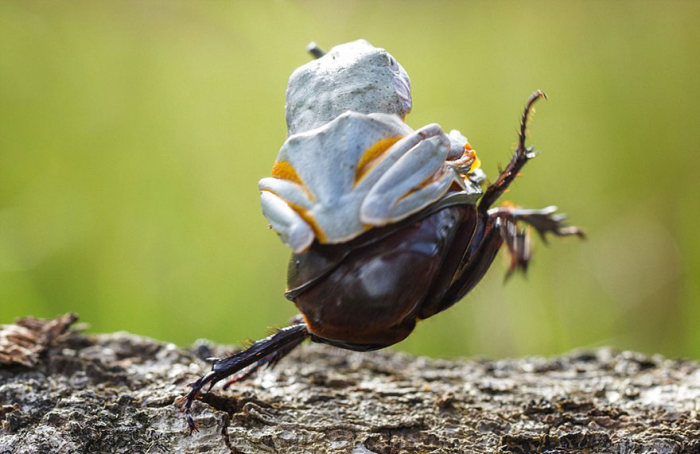|
|
Frog Riding A Beetle
|
Beetles are not only pests, but can also be beneficial, usually by controlling the populations of pests. One of the best, and widely known, examples are the ladybugs or ladybirds (family Coccinellidae). Both the larvae and adults are found feeding on aphid colonies. Other ladybugs feed on scale insects and mealybugs. If normal food sources are scarce, they may feed on small caterpillars, young plant bugs, or honeydew and nectar. Ground beetles (family Carabidae) are common predators of many different insects and other arthropods, including fly eggs, caterpillars, wireworms, and others.
Dung beetles (Scarabidae) have been successfully used to reduce the populations of pestilent flies and parasitic worms that breed in cattle dung. The beetles make the dung unavailable to breeding pests by quickly rolling and burying it in the soil, with the added effect of improving soil fertility, tilth, and nutrient cycling. The Australian Dung Beetle Project (1965–1985), led by Dr. George Bornemissza of the Commonwealth Scientific and Industrial Research Organization, introduced species of dung beetle to Australia from South Africa and Europe, and effectively reduced the bush fly (Musca vetustissima) population by 90%.
Dung beetles play a remarkable role in agriculture. By burying and consuming dung, they improve nutrient recycling and soil structure. They also protect livestock, such as cattle, by removing dung, which, if left, could provide habitat for pests such as flies. Therefore, many countries have introduced the creatures for the benefit of animal husbandry. In developing countries, the beetle is especially important as an adjunct for improving standards of hygiene. The American Institute of Biological Sciences reports that dung beetles save the United States cattle industry an estimated US$380 million annually through burying above-ground livestock feces.
Some beetles help in a professional setting, doing things that people cannot; those of the family Dermestidae are often used in taxidermy and preparation of scientific specimens to clean bones of remaining soft tissue. The beetle larvae are used to clean skulls because they do a thorough job of cleaning, and do not leave the tool marks that taxidermists' tools do. Another benefit is, with no traces of meat remaining and no emulsified fats in the bones, the trophy will not develop the unpleasant dead odor. Using the beetle larvae means that all cartilage is removed along with the flesh, leaving the bones spotless.
|
|









